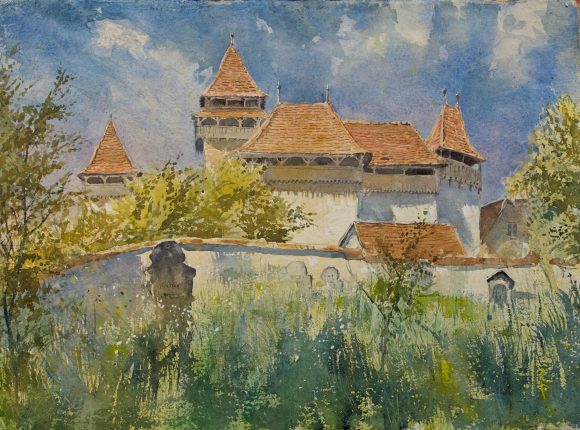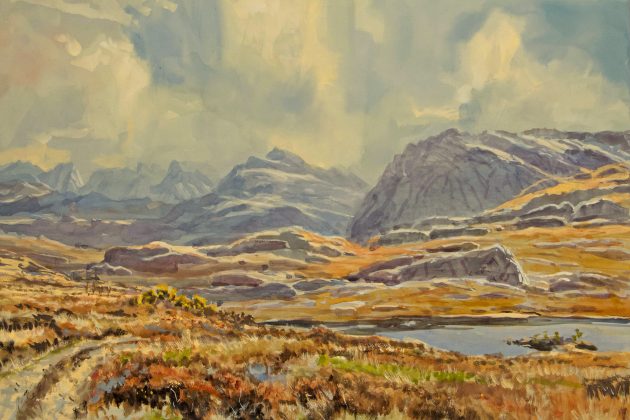Tim Scott Bolton talks to Janet Menzies about his work for HM The King and the complexity of capturing true wilderness on canvas
From the Himalayas to the Andes to Arctic Russia, Tim Scott Bolton has journeyed through some of the world’s least travelled places. Yet from an artist’s point of view, he has a slight quibble: “The problem with true wilderness is that there is nowhere to look. It is all incredible and you might experience it in an emotional way, but it needs some focus to galvanise what you are seeing. So it is difficult to create a good picture.”

He is happy to be considered a topographical artist, “like Edward Lear, where you are in a particular place at a particular time. I like to be honest in my painting, but there seem never to be enough opportunities to create a good picture and be honest. A picture is not a straight reproduction of the view; it is about focus and peripheral vision. Where you put your horizon makes a big difference to what your painting says.” For Scott Bolton, the scenery of the Scottish Highlands provides the ideal composition – both pictorially and narratively. He explains: “You can be honest and romantic at the same time through your instinctive reaction to the landscape. In the Highlands obviously you have the natural beauty, which is breathtaking – the variety of scenery and the distant hills and the light. On a still midsummer’s evening, at about 10 o’clock, the cerulean sky is mirrored in the loch below.”
Scott Bolton warns: “The difficulty of painting in Scotland, other than the midge, is that you have a preconceived idea of how to portray the Highlands from such artists as Alfred de Breanski, Landseer or the contemporary McPhail and MacGillivray, and this can interrupt your true observation of what is actually there.” So, when on a recent evening visit to Gairloch, the saturated colours and the clear, light palette were more influenced by the Scottish Colourists.

But the key element for Scott Bolton is the presence of man – actual or implied – giving focus to the scene: “I want to capture the interaction between wilderness and man, which is particularly attractive in Scotland. I like it when mankind works with the landscape and not against it. Where man has responded to the landscape you can get a beautiful result, like the view of a small village nestling in a valley. There is a beauty in a road that meanders around the contours, rather than driving straight through it.” This may be why Scott Bolton has found himself drawn towards painting complex and beautiful fishing maps. If there was a landscape that perfectly expresses man in harmony with his surroundings, it is surely the fishing river.
Scott Bolton explains: “I am a keen salmon fisher and my first fishing map was a gift to my father-in-law, who used to take me to the River Brora. Then I was commissioned by Roxtons to make fishing maps of the Varzuga and Kitsa rivers in the Russian Kola Peninsula. These wonderful primeval rivers within the Arctic Circle, running through the unremitting forest of fir and birch, presented a challenge of where to rest the eye and create a composition.”

Scott Bolton started out as a land agent, first in Yorkshire and then in Kenya, where he eventually began to work as an artist. He believes that his interest in the relationship between man and his natural environment probably stems from those early years in land management, and confesses: “I am really only now taking myself seriously as an artist. I saw myself as a land agent who loved painting. Now, after 50 years, I am finally feeling confident about my work.” He has every reason to be, as one of HM King Charles III’s favourite artists who accompanied The King and The Queen Consort as the official artist on their first state visit, to Germany, earlier this year. “The King often takes artists with him on tours; it is a practice he began when he was Prince of Wales. He gives you totally free rein. I think The King is the most visionary monarch – he has always been way ahead of his time.”

His latest project is also for The King, establishing an art gallery in Romania at His Majesty’s own property in the village of Viscri, Transylvania. As Prince of Wales, The King visited Romania for the first time in 1998 and often returns. He set up The Prince of Wales’ Foundation Romania in 2015 to preserve traditional farming and crafts in the area and promote eco-tourism. Scott Bolton explains: “I first met The King through Romania – he liked my pictures and bought some. This summer I have been setting up an exhibition at The King’s house, which will be the inauguration of the new gallery there.” It is possible to stay at one of The King’s projects in Zalanpatak, Transylvania – the perfect opportunity to see the work of artist and monarch interacting with a beautiful landscape.
For details of Tim Scott Bolton’s exhibitions and books, visit: timscottbolton.co.uk His latest book, A Brush with Rivers, is published by The Medlar Press, £35. Scott Bolton has also exhibited at the Harvey & Woodd Gallery, 4 Dundas Street, Edinburgh EH3 6HZ. To book a stay in one of The King’s project properties in Transylvania, visit: zalan.transylvaniancastle.com




